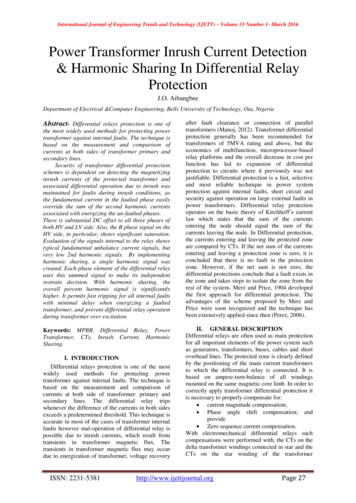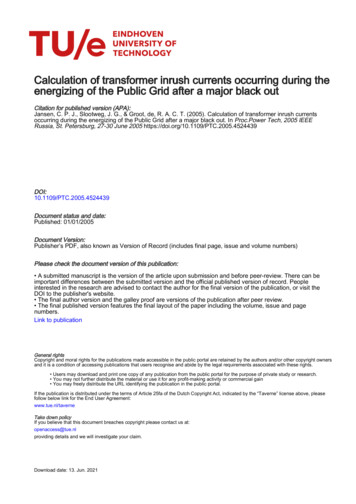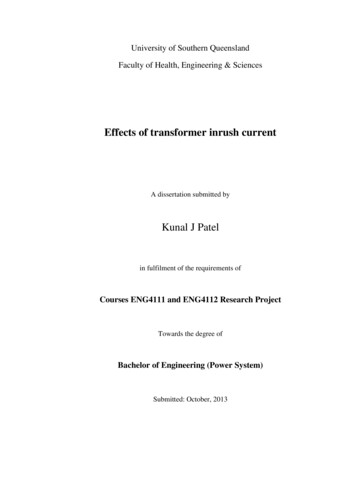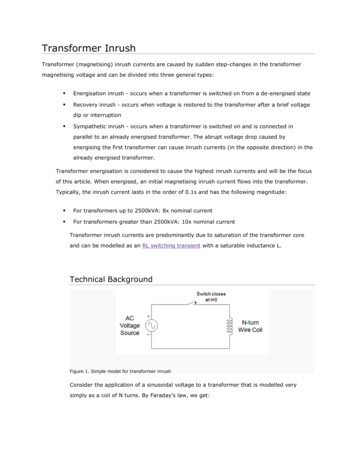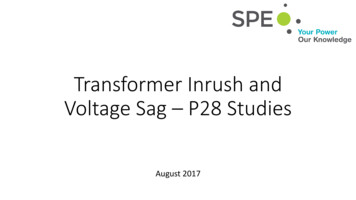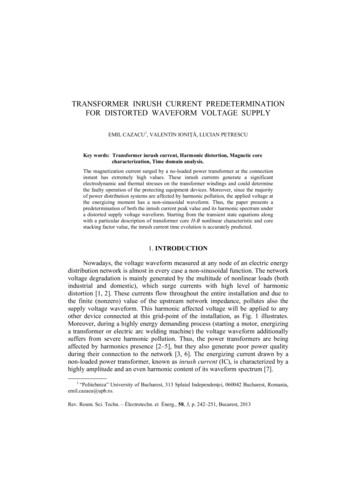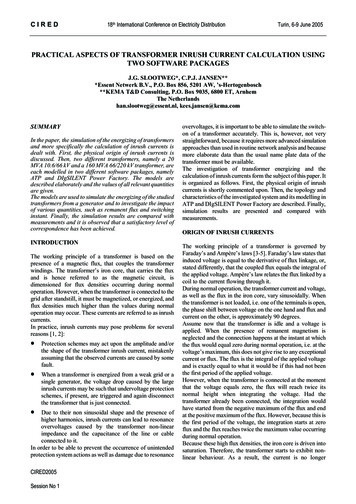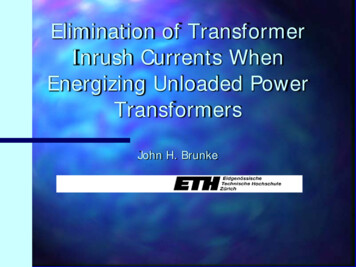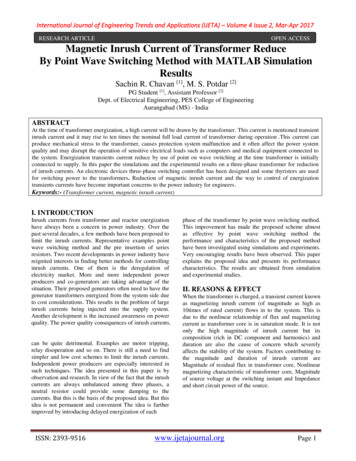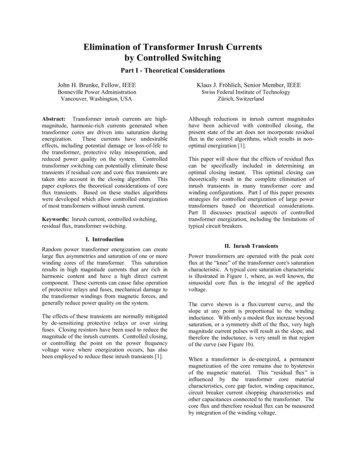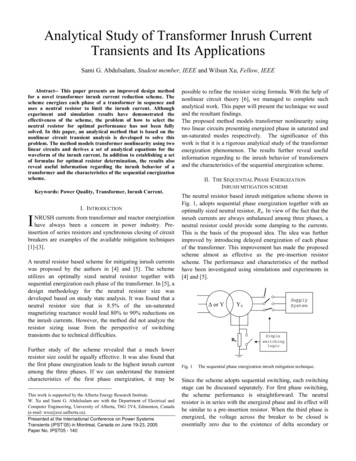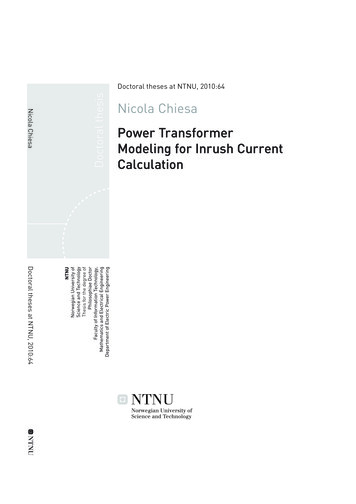
Transcription
Nicola ChiesaDoctoral theses at NTNU, 2010:64iDoctoral thesisiNTNUNorwegian University ofScience and TechnologyThesis for the degree ofPhilosophiae DoctorFaculty of Information Technology,Mathematics and Electrical EngineeringDepartment of Electric Power Engineeringii“PhDThesis” — 2010/5/28 — 14:59 — page a — #1iDoctoral theses at NTNU, 2010:64Nicola ChiesaPower TransformerModeling for Inrush CurrentCalculationiii
ii“PhDThesis” — 2010/5/28 — 14:59 — page b — #2iiiiii
ii“PhDThesis” — 2010/5/28 — 14:59 — page c — #3iiNicola ChiesaPower Transformer Modelingfor Inrush Current CalculationThesis for the degree of Philosophiae DoctorTrondheim, June 2010Norwegian University of Science and TechnologyFaculty of Information Technology,Mathematics and Electrical EngineeringDepartment of Electric Power Engineeringiiii
ii“PhDThesis” — 2010/5/28 — 14:59 — page d — #4iiNTNUNorwegian University of Science and TechnologyThesis for the degree of Philosophiae DoctorFaculty of Information Technology,Mathematics and Electrical EngineeringDepartment of Electric Power Engineering Nicola ChiesaISBN 978-82-471-2086-6 (printed ver.)ISBN 978-82-471-2087-3 (electronic ver.)ISSN 1503-8181Doctoral theses at NTNU, 2010:64Printed by NTNU-trykkiiii
ii“PhDThesis” — 2010/5/28 — 14:59 — page e — #5iito Laura,endless spring of love and joy.iiii
ii“PhDThesis” — 2010/5/28 — 14:59 — page f — #6iiiiii
ii“PhDThesis” — 2010/5/28 — 14:59 — page i — #7iiPrefaceThis thesis is the result of my work at the Department of Electric Power Engineering atthe Norwegian University of Science and Technology (NTNU) from 2005 to 2009. Themain topic of the project is the investigation of power transformer behavior under switchingoperation, with special attention to the inrush current phenomena. This Ph.D. project hasbeen part of the KMB project “Thermal and electromagnetic performance of transformers”supervised by SINTEF Energy Research and supported by the Norwegian Research Council,Hafslund Nett, Statnett SF, Statkraft Energi AS, NVE, EDF, Nynäs Petroleum AB, as well asABB.First and foremost I would like to thank my supervisor Prof. Hans Kristian Høidalen, who hasbeen my mentor since I first arrived in Norway in 2004. At that time I was a young and inexperienced student pursuing my first accademic achievement, the M.Sc. Thank you for givingme the opportunity to develop as a researcher and reach this new, bigger accomplishment, thePh.D. Hopefully we will continue our collaboration in the future, as well.I own Prof. Bruce Mork many thanks for his many advices and insightful discussions duringthese four years. Thank you for inviting me to stay at your Department of Electrical &Computer Engineering at Michigan Technological University. I also would like to thank thewhole research team at MTU, in particular Alejandro Avendaño and Dmitry Ishchenko.I am very thankful to the people working in the NTNU Service Lab and Workshop, as wellas to many SINTEF Energy Research employees for their help with my experimental setup.In particular, I would like to thank Bård Almås, Vladimir Kublicka, Oddvar Landrø, and lastbut certainly not least, Horst Førster.I have been employed at SINTEF Energy Research, Department of Energy System sinceSeptember 2009. I would like to thank my employer and my colleges for their understandingand support during the finishing phase of my thesis. It has been an honor to start workingwith you and be part of a prestigious research center.Beyond all doubt, I am very happy I have had the fortune to meet many good friends inTrondheim and Michigan, within and outside the university, and from all the corners of theworld. You are too many to be named, thank you for making these years unforgettable.I want to express all my gratitude to my father Mario, mother Mirella and brother Lorenzo.Thank you for always believing in me, I could have never make it so far without your supportas a family. You will always be in my heart even if I will not be so close to you – geographically. To all my relatives from the Chiesa and Mangili families, thank you to make me feelalways close to you and beying a large united family. A special thank goes to my cousinsMatteo and Luisa for sharing with me their interest in scientific research and being always asource of inspiration. We should write our first article together now.Finally, the most important person in my life is my girlfriend Laura. Thank you for beingsupportive in these last busy months. It is your turn now, I will do my best to help you finishyour Ph.D. In front of us is only a wonderful future, together we will discover unforgettablemoments and extraordinary emotions.Trondheim, April 2010Nicola Chiesa-iiiii
ii“PhDThesis” — 2010/5/28 — 14:59 — page ii — #8iiP OWER T RANSFORMER M ODELING FOR I NRUSH C URRENT C ALCULATION-iiiiii
ii“PhDThesis” — 2010/5/28 — 14:59 — page iii — #9iiAbstractIn this thesis a general purpose transformer model for low and medium frequency transientstudies is developed and verified. The inrush current phenomena during no-load energizationof power transformer is analyzed with special attention. The main challenge is to develop ageneral model that is valid for a wide range of studies, while it relies on a limited number ofcommonly available input data. The development of such engineering model is the ultimateresearch goal.The power transformer is an essential component in power systems and with exception oftransmission lines, it has the greatest exposure to electrical transients of all devices. Themodels used to predict its transient behaviors are however not always adequate due to bothlack of data/measurements and knowledge. Situations of special concern are inrush currents,switching and lightning impulse stresses, induced overvoltages and harmonics.To predict the electromagnetic stresses on transformers, a calculation model must be established. The single-phase based equivalent representation used in most of the present simulation packages does not sufficiently account for the coupling between phases and the differences caused by various iron core structures. The representation of hysteresis, anomalouslosses and remanence also needs improvements.A valuable way to achieve a deeper understanding of the inrush current phenomena is throughextensive laboratory measurements on distribution transformers and field measurements onpower transformers. Experimental data are highly beneficial in the verification of the developed model.Research questions: Parameter estimation is complex and not fully standardized. It may be a source oferror both in the way parameters are measured and post processed. When saturation is a concern, the importance of a correct representation of the core isoften underestimated. Several factors have to be taken into account as core topology,behavior in extreme saturation, residual flux initialization. Manual initialization of the residual fluxes in a transformer model is not simple. Theunderstanding of the deenergization transient is important for the appropriate estimation of the residual flux values.Main contributions: The development of a general transformer model for transient studies. A proposed method for parameter estimation supported by sensitivity studies. Systematic measurements and simulations of ringdown and inrush transients have revealed novel patterns in the inrush current first peak. Potential contribution to new mitigation methods. Measurements on three large power transformers of several MVA.-iiiiiii
ii“PhDThesis” — 2010/5/28 — 14:59 — page iv — #10iiP OWER T RANSFORMER M ODELING FOR I NRUSH C URRENT C ALCULATION-iviiii
ii“PhDThesis” — 2010/5/28 — 14:59 — page v — #11iiUnits of MeasurementM AGNETIC C IRCUITSNAMESYMBOL [UNIT]EQUATIONF [A-t]F NIH [A-t/m]H N I/l(l length)Flux densityB [T] [Wb/m2 ]B µHPermeabilityµ [H/m]µ µ 0 µrµ0 4π10 7FluxΦ [Wb]Φ BA(A cross-sectional area)Flux linkageλ [Wb-t]λ NΦInductanceL [H]L λ/I N 2 /R N 2 ΛReluctanceR [H 1 ]R 1/ΛPermeanceΛ [H]Λ µ0 µr A/lMagnetomotive force (mmf)Magnetic field intensityO HM ’ S L OW A NALOGYELECTRICMAGNETICV RIF RΦCurrentI [A]Φ [Wb]FluxemfV [V]F [A-t]mmfResistanceR [Ω]Conductivityσ [S/m]R[H 1 ]µ [H/m]ReluctancePermeability-viiii
ii“PhDThesis” — 2010/5/28 — 14:59 — page vi — #12iiP OWER T RANSFORMER M ODELING FOR I NRUSH C URRENT C ALCULATION-viiiii
ii“PhDThesis” — 2010/5/28 — 14:59 — page vii — #13iiC ONTENTSPrefaceiAbstractiiiUnits of MeasurementvContentsviiList of FiguresixList of Tablesxi12Introduction1.1 Scope of Work .1.2 Research Context1.3 Thesis Outline . .1.4 Publications . . .12446Background / State of the Art2.1 Low-frequency Transformer Modeling . . . . . . . .2.1.1 Models based on a magnetic circuit . . . . .2.1.2 Models based on an equivalent electric circuit2.1.3 Model based on an hybrid approach . . . . .2.1.4 Parameter estimation . . . . . . . . . . . . .2.1.5 Extension to higher frequency . . . . . . . .2.2 Inrush Current . . . . . . . . . . . . . . . . . . . . .2.2.1 Simulation of inrush current transients . . . .2.2.2 Analytical calculation of inrush current . . .2.2.3 Inrush current mitigation techniques . . . . .910111318202223242730.-viiiiii
ii“PhDThesis” — 2010/5/28 — 14:59 — page viii — #14iiP OWER T RANSFORMER M ODELING FOR I NRUSH C URRENT C ALCULATION2.2.4 Ringdown transient and residual fluxes . . . . . . . . . . .Iron Core Modeling . . . . . . . . . . . . . . . . . . . . . . . . . .2.3.1 Dynamic hysteresis models . . . . . . . . . . . . . . . . . .Challenges in Power Transformer Modeling for Inrush Current Calculation . . . . . . . . . . . . . . . . . . . . . . . . . . . . . . . .313234Inrush Current Measurements3.1 Laboratory setup . . . . . . . . . . . . . . . . . . . . . . . . . . .3.1.1 Test objects, configuration and measuring equipment . . . .3.1.2 Data acquisition procedure . . . . . . . . . . . . . . . . . .3.2 Systematic measurements on a 300 kVA and 800 kVA distributiontransformers . . . . . . . . . . . . . . . . . . . . . . . . . . . . . .3.3 Field measurements on large transformers . . . . . . . . . . . . . .3.3.1 Field measurement 1, 300 MVA . . . . . . . . . . . . . . .3.3.2 Field measurement 2, 50 MVA . . . . . . . . . . . . . . . .3.3.3 Field measurement 3, 300 MVA . . . . . . . . . . . . . . .373737414Discussion4.1 Model Development . . . . . . . . . . . . . . . . . . . . . . . . .4.2 Leakage Model . . . . . . . . . . . . . . . . . . . . . . . . . . . .4.3 Jiles-Atherton Model . . . . . . . . . . . . . . . . . . . . . . . . .676772795Conclusions5.1 Contribution of the Publications . . . . . . . . . . . . . . . . . . .5.2 Concluding Remarks . . . . . . . . . . . . . . . . . . . . . . . . .5.3 Recommendations for Further Work . . . . . . . . . . . . . . . . .919196962.32.43References36445758616199A Implementation of the Jiles-Atherton Model in ATP111B Journal Publications and Conference ProceedingsAnalytical algorithm for the calculation of magnetization and loss curvesof delta connected transformers . . . . . . . . . . . . . . . . . . . .On the ringdown transient of transformers . . . . . . . . . . . . . . . . .Hysteretic iron-core inductor for transformer inrush current modeling inEMTP . . . . . . . . . . . . . . . . . . . . . . . . . . . . . . . . .Systematic switching study of transformer inrush current: simulation andmeasurements . . . . . . . . . . . . . . . . . . . . . . . . . . . . .Transformer model for inrush current calculations: simulations, measurements and sensitivity analysis . . . . . . . . . . . . . . . . . . . . .Novel approach for reducing transformer inrush currents. Laboratory measurements, analytical interpretation and simulation studies . . . . .115117137155173193219-viiiiiii
ii“PhDThesis” — 2010/5/28 — 14:59 — page ix — #15iiL IST OF F IGURES2.12.22.32.42.52.62.72.8Low frequency model of a single phase transformer. . . . . . . . . .Model based on a magnetic circuit. . . . . . . . . . . . . . . . . . .Model based on an equivalent electric circuit. . . . . . . . . . . . .Duality transformation: identification of the equivalent components.Duality transformation: series and parallel equivalent connections. .Duality transformation: derivation of a dual circuit. . . . . . . . . .Model based on a hybrid approach. . . . . . . . . . . . . . . . . . .Qualitative representation of the inrush current phenomenon and theeffect of the residual flux. . . . . . . . . . . . . . . . . . . . . . . .2.9 Analytical estimation of inrush current. . . . . . . . . . . . . . . .2.10 Modeling of a nonlinear iron-core inductor. . . . . . . . . . . . . .2.11 Loss components contributing to total iron loss in grain oriented material electrical steel. . . . . . . . . . . . . . . . . . . . . . . . . .101214161617193.13.238Laboratory layout. . . . . . . . . . . . . . . . . . . . . . . . . . . .Test objects: 800 kVA transformer on the left, 300 kVA transformeron the right. . . . . . . . . . . . . . . . . . . . . . . . . . . . . . .3.3 Connection of the high voltage deviders and vacuum breakers. Thevoltage deviders are connected directly to the transformer terminalsin the final set-up. . . . . . . . . . . . . . . . . . . . . . . . . . . .3.4 GUI for the transient recorder. . . . . . . . . . . . . . . . . . . . .3.5 Structured text file specifing the timings for automated multiple measurements. . . . . . . . . . . . . . . . . . . . . . . . . . . . . . . .3.6 Trigger signals and systematic variation of the switching times. . . .3.7 Double triggering procedure. . . . . . . . . . . . . . . . . . . . . .3.8 Ringdown transient, 300 kVA transformer. . . . . . . . . . . . . . .3.9 Inrush current transient, 300 kVA transformer. . . . . . . . . . . . .3.10 Ringdown transient, 800 kVA transformer. . . . . . . . . . . . . . .24
A valuable way to achieve a deeper understanding of the inrush current phenomena is through extensive laboratory measurements on distribution transformers and field measurements on power transformers. Experimental data are highly beneficial in the verification of the devel-oped model. Research questions:

